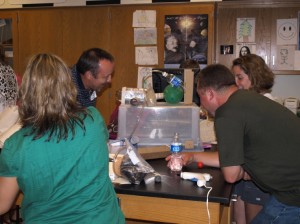Professional Development Options
By Mary Bigelow
Posted on 2014-07-22
 I was recently appointed K-12 science department chairperson. Our professional development budget is slim, but I’d like to do something other than the generic “sit-and-git” presentations we’ve had in the past. I’ve heard about using social media and other online resources for professional development. I’m open to any other ideas, too. Where should we start?
I was recently appointed K-12 science department chairperson. Our professional development budget is slim, but I’d like to do something other than the generic “sit-and-git” presentations we’ve had in the past. I’ve heard about using social media and other online resources for professional development. I’m open to any other ideas, too. Where should we start?
—Lauren, Lowell, Massachusetts
This is a chance to tailor professional development (PD) to the needs of your science teachers, rather than trying to fit your colleagues into one-size-fits-all events (especially since elementary and secondary science teachers may have different needs). First, ask your administrator for state or local PD requirements and the district views on independent study and teacher-directed activities. Find out what types of pre-approval and documentation might be required for nontraditional or off-site activities.
Then ask the science teachers to examine the curriculum to identify science topics in which they need background knowledge or cutting-edge topics and instructional strategies for which they would like more information. Examine areas in which your students are struggling. You have a chance to identify specific areas of need, such as inquiry, lesson design, notebooks, formative assessments, laboratory procedures, safety, reading/writing in science, inclusion, technology integration, or classroom management. The Next Generation Science Standards could certainly be a focus area. NSTA has a variety of resources to help teachers learn about and use them. (See the NGSS@NSTA hub.)
The result of your survey should be individual or group goals reflecting your teachers’ needs. You and the teachers can then find or develop PD activities to meet those goals and describe how you will chart the progress toward meeting them, including teacher logs of their learning. Giving teachers ownership of the content and structure of their PD will improve their buy-in to the process, although those who have had negative experiences in the past may still be skeptical.
This kind of personalized PD will require as much (if not more) work than traditional workshops and presentations. Rather than putting together an extensive list of unrelated events, be sure your activities are connected to your identified needs and goals:
- Teachers active on social media such as e-mail lists, blogs, discussion forums, and Twitter (check out NSTA’s Social Media Dashboard) can post requests for lesson ideas, recommend video clips and websites, share textbook reviews, or add suggestions for classroom management. Thanks to the quick thinking and generosity of our colleagues, teachers can get a wealth of just-in-time replies to their immediate needs. Some Tweetchats and discussion threads are tailored to specific issues and can be used throughout the year (#nsta and #scichat are two that I monitor regularly). NSTA has Community Forums and e-mail lists that have many suggestions and resources from our colleagues, just in time.
- The resources at the NSTA Learning Center can also be a part of your plan. It would be easy to incorporate these into your goals, and many are free to NSTA members. The resources include Science Objects related to content, online web seminars (many other professional organizations charge for these), journal archives, the option to create and share resource collections, and free book chapters.
- Reading the K-12 NSTA journals—The Science Teacher, Science Scope,and Science & Children—is an easy way to stay current on both pedagogy and content, and your membership includes online access to all of them, including the archives. Teacher book discussion groups can take advantage of NSTA journals articles, book chapters, and other publications.
- Think outside of the traditional workshop box to consider action research projects, independent study, presentations by your own teachers, online courses, conferences, collaborations with other school districts whose teachers have similar needs, and collaborations with professional scientists or university staff (both online and in person). Or try your own version of the Iron Science Teacher.
- Consider informal science activities, including field trips to local science museums, nature centers, zoos, or parks. Many of these may offer PD sessions and their staff can be valuable resources.
There may be times when everyone will need the same training. For example,if the school is implementing new software for attendance, grading, or communications, then all teachers and staff need the training and subsequent updates. Other science-related topics—such as safety or updates on regulations and policies are important enough to require periodic training events for all.
Work with your administrators to design a format for reporting not just the PD topics and the hours but also a discussion of how these activities have improved teachers’ content knowledge and instructional skills. Invite administrators to your events and into the classrooms to see the results.
Disclaimer: The views expressed in this blog post are those of the author(s) and do not necessarily reflect the official position of the National Science Teaching Association (NSTA).


